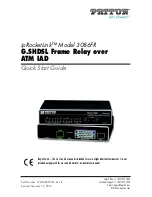
14-2
Cisco 1800 Series Integrated Services Routers (Fixed) Software Configuration Guide
OL-6426-02
Chapter 14 Troubleshooting
ADSL Troubleshooting
•
Brief description of the steps you have taken to isolate the problem
ADSL Troubleshooting
If you experience trouble with the ADSL connection, verify the following:
•
The ADSL line is connected and is using pins 3 and 4. For more information on the ADSL
connection, see the hardware guide for your router.
•
The ADSL CD LED is on. If it is not on, the router may not be connected to the DSL access
multiplexer (DSLAM). For more information on the ADSL LEDs, see the hardware installation
guide specific for your router
.
•
The correct Asynchronous Transfer Mode (ATM) virtual path indentifier/virtual circuit identifier
(VPI/VCI) is being used.
•
The DSLAM supports discrete multi-tone (DMT) Issue 2.
•
The ADSL cable that you connect to the Cisco router must be 10BASE-T Category 5, unshielded
twisted-pair (UTP) cable. Using regular telephone cable can introduce line errors.
SHDSL Troubleshooting
Symmetrical high-data-rate digital subscriber line (SHDSL) is available on the Cisco 1803 router model.
If you experience trouble with the SHDSL connection, verify the following:
•
The SHDSL line is connected and using pins 3 and 4. For more information on the G.SHDSL
connection, see the hardware guide for your router.
•
The G.SHDSL LED is on. If it is not on, the router may not be connected to the DSL access
multiplexer (DSLAM). For more information on the G.SHDSL LED, see the hardware installation
guide specific for your router
.
•
The correct asynchronous transfer mode (ATM) virtual path indentifier/virtual circuit identifier
(VPI/VCI) is being used.
•
The DSLAM supports the G.SHDSL signaling protocol.
Use the
show controllers dsl 0
command in privileged EXEC mode to view an SHDSL configuration.
PortFast Troubleshooting
PortFast is a feature that you typically enable for a port or interface that connects to a host. When the
link comes up on this port, the bridge skips the first stages of the STA and directly transitions to
forwarding mode.
If you use the PortFast feature on switch ports or interfaces that connect to other switches, hubs, or
routers, a network loop might get created. If the looped traffic is heavy, the bridge might experience
problems with the successful transmission of the BPDU that stops the loop. This problem could delay
convergence, or in extreme cases, bring down the network.
Caution
Do not use the PortFast feature on switch ports or interfaces that connect to other switches, hubs, or
routers. Otherwise, you might create a network loop.
Summary of Contents for 1801
Page 21: ...P A R T 1 Getting Started ...
Page 22: ......
Page 39: ...P A R T 2 Configuring Your Router for Ethernet and DSL Access ...
Page 40: ......
Page 119: ...P A R T 3 Configuring Additional Features and Troubleshooting ...
Page 120: ......
Page 157: ...P A R T 4 Reference Information ...
Page 158: ......















































